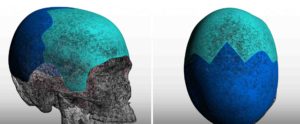Aesthetic augmentation of the head can now be effectively done using custom skull implants made from a 3D CT scan. With 3D designing software the zone of skull augmentation can be clearly identified and an implant designed to cover it and create an improved head shape. This is a far superior technique to the use of traditional use of bone cements both in assurance of a smooth contour and the ability to cover broader surface areas.
With preoperative designing a custom skull implant can be made to cover the entire head if desired. This creates for the first time the ability to truly increase the size of the head and/or change its shape within the confines of the ability of the scalp to stretch and accommodate it.


The sides of the implant that extends into the anterior temporal region must be very soft and thin as they will be right under the skin on top of the temporalis fascia. It is not possible with a implant that sits on the bone over the top of the head to have its sides or temporal sections be under the fascia. But with very tapered edges it will not create a visible implant edge.
Dr. Barry Eppley
Indianapolis Indiana


